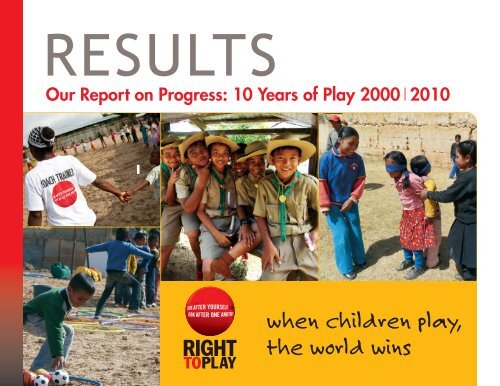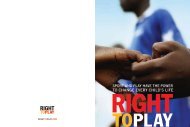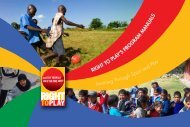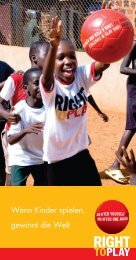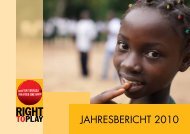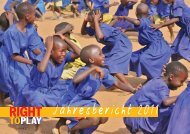Results_Layout DRAFT November 22.pdf
Create successful ePaper yourself
Turn your PDF publications into a flip-book with our unique Google optimized e-Paper software.
RESULTS<br />
Our Report on Progress: 10 Years of Play 2000 I 2010<br />
when children play,<br />
the world wins
2<br />
1<br />
2<br />
Right To Play has been called a<br />
pioneer in the global Sport for<br />
Development movement. Can you<br />
comment on that?<br />
“Right To Play is a pioneer in the<br />
Sport for Development arena for<br />
two reasons: we have programs in<br />
over 20 countries, reaching more<br />
than 700,000 children every week.<br />
We have a great methodology that<br />
is making a difference on the<br />
ground. In addition, we have<br />
worked in the area of policy to<br />
effect change in government and<br />
United Nations’ interests, knowledge,<br />
and their behaviour toward<br />
investment in children’s holistic<br />
development through Sport for<br />
Development programs.”<br />
How have you been impacted by<br />
your visits to field projects?<br />
“One of my most memorable visits<br />
was in the south of Uganda in a<br />
health clinic at a refugee camp. We<br />
were visiting girls affected by HIV<br />
and AIDS, one of whom was about<br />
seven or eight months old, born to a<br />
16-year-old mother. I asked what<br />
they could do for her, and [the clinic<br />
3<br />
Reflecting on 10 Years of Play<br />
Interview with Johann Olav Koss, President and CEO<br />
workers] said, ‘Absolutely nothing.’<br />
The little girl died just hours after I left<br />
the clinic. I understood then that we<br />
had to make a difference. We had to<br />
create play programs that would<br />
enable children to make decisions for<br />
their own personal protection from<br />
HIV and AIDS – understanding the<br />
disease, protecting themselves from<br />
it, and what they can do to prevent<br />
future infections, and that girls in<br />
particular should be the focus.<br />
What does it mean to you to have<br />
inspired other athletes to devote<br />
their time and resources to<br />
humanitarian efforts?<br />
“We have engaged athletes from all<br />
around the world. We have had the<br />
opportunity to talk with them about<br />
their role in society and how they can<br />
make a change. I’m really proud to<br />
say that we have involved over 400<br />
athletes around the world in making<br />
a difference every single day.<br />
Athletes are role models– they can<br />
really stand up for children’s rights<br />
and give them the chance to play,<br />
and do that anywhere in the world.”<br />
4<br />
5<br />
What are some of the things that<br />
make you proud to mark 10 years<br />
with Right To Play?<br />
“One thing I am most proud of is the<br />
incredible accomplishments we have<br />
had in the field. The 13,000 Coaches<br />
and Leaders who are implementing the<br />
programs every day or on a weekly<br />
basis make me proud. Those Leaders in<br />
their communities are making a<br />
tremendous effort and are making a<br />
difference in children’s lives every<br />
single day. And those individuals,<br />
together with all the staff we have<br />
around the world, are the people and<br />
the inspiration to drive this work<br />
forward and that’s what I’m most<br />
proud of.”<br />
What have you learned as a global<br />
leader and a participant in<br />
international development goals?<br />
“What I’ve learned as a leader is the<br />
importance of sticking to the mission<br />
and the vision of the organization, not<br />
taking anything for granted but<br />
working towards and through the<br />
challenges that surface. Being part of a<br />
leadership circle with many<br />
international organizations has<br />
6<br />
certainly strengthened our<br />
credibility, but has also given me<br />
the experience and the<br />
understanding of the challenges<br />
they are overcoming, which are<br />
very similar to what we have seen<br />
on a daily basis.<br />
What are your goals for Right To<br />
Play’s next 10 years?<br />
“My goal for Right To Play over the<br />
next 10 years is to put us on a<br />
sustainable path – making sure<br />
that programs and activities in the<br />
local communities can be<br />
sustained, replicated, and are<br />
accessible to all children. This is a<br />
critical element to the areas [in<br />
which] we are currently already<br />
working.<br />
Secondly, we need to work with<br />
governments and institutions<br />
around the world to further<br />
enhance the Sport for Development<br />
agenda, so that institutions like the<br />
United Nations incorporate Sport<br />
for Development into their poverty<br />
reduction strategic plans and other<br />
elements of their national
7<br />
development plans so that this<br />
becomes a priority in the future. If<br />
these two elements of program<br />
sustainability and policy<br />
implementation can happen over<br />
the next 10 years, we will ensure<br />
that the future generation of<br />
children will have access to sport<br />
and play.<br />
If you could speak to each of Right<br />
To Play’s supporters to thank<br />
them, what would you say?<br />
“To all of you who have supported<br />
Right To Play over the last 10 years:<br />
Thank you very much. We would<br />
not be where we are today without<br />
your support. Your financial<br />
contribution has been leveraged,<br />
and we can proudly say we’ve been<br />
effective in reaching the results of<br />
holistic child development, basic<br />
education, and disease and conflict<br />
prevention for the children in the<br />
more than 20 countries in which<br />
we work.<br />
Thank you for your belief in us and<br />
thank you for continuing to support<br />
us over the next 10 years.”<br />
Right To Play<br />
At A Glance<br />
Right To Play allows children the<br />
opportunity to build critical life<br />
skills through sport and play –<br />
ultimately creating social change<br />
in communities affected by war,<br />
poverty and disease.<br />
As the leading international<br />
humanitarian and development<br />
organization using the<br />
transformative power of sport and<br />
play to build essential skills in<br />
children, we offer children the tools<br />
to become contributing participants<br />
in society.<br />
Right To Play trains local community<br />
leaders as Coaches to deliver our<br />
programs to some of the most<br />
marginalized children in countries<br />
affected by war, poverty and<br />
disease in Africa, Asia, the Middle<br />
East, and South America. Our work<br />
is guided by the United Nations<br />
Convention on the Rights of the<br />
Child and involves a unique<br />
methodology that encourages longterm<br />
behaviour change. We achieve<br />
this by using sport and play as tools<br />
for learning in four critical areas of<br />
development: basic education and<br />
child development; health promotion<br />
and disease prevention; conflict<br />
resolution and peace building;<br />
and, community development<br />
and participation.<br />
Right To Play programs are shaped<br />
by two guiding principles: inclusion<br />
and sustainability. These principles<br />
promote the involvement of all<br />
children and young people who<br />
may be marginalized for reasons of<br />
gender, disability, ethnicity, social<br />
background or religion, and ensure<br />
a lasting impact that centres on<br />
building the capacity of individuals,<br />
communities and partner<br />
organizations to independently<br />
deliver learning objectives through<br />
regular sport and play activities.<br />
Global Leader in Sport for<br />
Development and Peace<br />
Right To Play is committed to every<br />
child’s right to play and takes an<br />
active role to facilitate research and<br />
promote advocacy in this area. Our<br />
aim is to engage and positively<br />
influence key decision-makers from<br />
the development, sport, business,<br />
media and government sectors to<br />
ensure every child benefits from the<br />
positive power of sport and play.<br />
An International Team of<br />
Athlete Ambassadors<br />
Athletes from more than 40<br />
countries support Right To Play. As<br />
role models, these athletes inspire<br />
children and raise awareness about<br />
Right To Play internationally.<br />
• In 2009, Right To Play reached<br />
more than 735,400 children in<br />
weekly regular sport and play<br />
activities.<br />
• The number of children reached<br />
through regular activity as well as<br />
through festivals, summer camps<br />
and other sports events was more<br />
than 1,177,000 in 2009.<br />
• These activities were facilitated by<br />
more than 13,000 local Coaches,<br />
Teachers and Leaders.<br />
• Almost 50 per cent of children<br />
participating in programs in 2009<br />
were girls.<br />
• More than 50 per cent of Coaches,<br />
Teachers and Leaders were<br />
female.<br />
• More than 400 Athlete<br />
Ambassadors currently support<br />
Right To Play worldwide.<br />
• In 2010, Right To Play operated 48<br />
projects and two special initiatives<br />
in 21 countries across four<br />
continents.<br />
3
4<br />
Charting Our Progress<br />
RESULTS 2010 is Right To Play’s biennial review of its programs since embarking<br />
upon our mission to improve the lives of children living in some of the world’s<br />
most disadvantaged communities. The information contained within the<br />
following pages offers a glimpse of Right To Play’s growth as an implementing<br />
organization, and a chronological overview of key points in Right To Play’s<br />
evolution as we celebrate our 10-year anniversary. Also included are highlights<br />
from evaluations conducted in eight project countries in three of the regions<br />
where Right To Play works.<br />
CHILDREN: Increase in Number of Children Participating in<br />
Right To Play Activities*<br />
By the end of 2001<br />
By the end of 2003<br />
By the end of 2005<br />
By the end of 2007<br />
By the end of 2009<br />
37,000 children<br />
404,000 children<br />
531,000 children<br />
724,000 children<br />
1,177,000 children<br />
*Number of children reached through regular activity plus festivals, summer<br />
camps and other sport events to date. In 2009 and 2010, Right To Play<br />
reached more than 700,000 children in regular sport and play activities<br />
alone.<br />
PROJECTS: Number of Right To Play Projects Worldwide<br />
By the end of 2001<br />
By the end of 2003<br />
By the end of 2005<br />
By the end of 2007<br />
By the end of 2009<br />
By mid-2010<br />
15 projects<br />
40 projects<br />
44 projects<br />
49 projects<br />
49 projects<br />
58 projects<br />
By the end of 2009, Right To Play reached more than 1 million children through<br />
regular sport and play activities as well as summer camps, Play Days and sport<br />
festivals. Children who participate in Right To Play sport and play-based<br />
programs gain valuable life skills such as confidence, collaboration, empathy<br />
and communication that contribute to their emotional well-being and social<br />
development.<br />
GOVERNMENTS AND UN AGENCIES: Increase in Number of<br />
Governments and UN Agencies Supporting Right To Play<br />
By the end of 2001<br />
By the end of 2003<br />
By the end of 2005<br />
By the end of 2007<br />
By the end of 2009<br />
LEADERS: Increase in Number of Local Leaders Actively Participating in Right<br />
To Play Programs*<br />
By the end of 2001<br />
By the end of 2003<br />
By the end of 2005<br />
By the end of 2007<br />
By the end of 2009<br />
3<br />
180 active Leaders<br />
2,300 active Leaders<br />
4,900 active Leaders<br />
8,200 active Leaders<br />
13,00 0 active Leaders<br />
*In 2008 Right To Play began to include teachers who were regularly leading<br />
children in activities as part of its count.<br />
7<br />
9<br />
12<br />
15
ATHLETE AMBASSADORS: Number of Athlete Ambassadors<br />
Involved with Right To Play*<br />
By the end of 2003<br />
By the end of 2005<br />
By the end of 2007<br />
By the end of 2009<br />
150 Ambassadors<br />
200 Ambassadors<br />
250 Ambassadors<br />
400 Ambassadors<br />
*Right To Play Athlete Ambassadors are international athletes who share Right<br />
To Play values, serve as role models for children around the world, and choose<br />
to participate in Right To Play activities without compensation.<br />
FINANCIALS: Increase in total revenue<br />
By the end of 2001<br />
By the end of 2003<br />
By the end of 2005<br />
By the end of 2007<br />
By the end of 2009<br />
1,799,200<br />
8,227,250<br />
14,653,000<br />
27,564,900<br />
28,460,600<br />
2009 FUNDING SOURCES: Percentage of Funding Derived of Organizations,<br />
Foundations, Corporations and Individuals covering 2009<br />
50.8%<br />
0.4% 1.3%<br />
32.5%<br />
15%<br />
Government Organizations<br />
Foundations<br />
Individuals and Corporations<br />
Others<br />
Donations-In-Kind<br />
COUNTRIES: Number of Countries where Right To Play Runs its Programs*<br />
By the end of 2001<br />
By the end of 2003<br />
By the end of 2005<br />
By the end of 2007<br />
By the end of 2009<br />
By mid-2010<br />
7 countries<br />
21 countries<br />
20 countries<br />
23 countries<br />
23 countries<br />
21 countries<br />
*In 2008 Right To Play made the decision to focus its strategy on going deeper<br />
rather than broader. Instead of expanding our footprint into more countries, we<br />
elected to improve upon our existing operations to ensure we delivered better,<br />
more sustainable programs, reached more children in those countries, increased<br />
quality in delivery, measured our results, and proved impact.<br />
In 2010 Right To Play operated in 21 countries: Benin, Botswana, Burundi, China, Ethiopia, Ghana, Jordan,<br />
Kenya, Lebanon, Liberia, Mali, Mozambique, Pakistan, Palestinian Territories (West Bank and Gaza), Peru,<br />
Rwanda, Sudan, Tanzania, Thailand, Uganda, and the United Arab Emirates.<br />
SOURCES OF FUNDING: Percentage of<br />
Funding Derived of Government<br />
Organizations over the Past Years<br />
By the end of 2001<br />
By the end of 2003<br />
By the end of 2005<br />
By the end of 2007<br />
By the end of 2009<br />
22%<br />
48%<br />
32.5%<br />
43.3%<br />
64.7%<br />
5
6<br />
Milestones 2000-2010<br />
Over the past 10 years, Right To Play has taken significant strides to become the leading international<br />
humanitarian and development organization using the transformative power of sport and play to build essential<br />
skills in children. Born out of a legacy project and an Olympian’s vision to make the world in which we live a<br />
safer, happier and healthier one for children living in some of the world’s most disadvantaged communities, this<br />
brief chronology outlines Right To Play’s growth, as well as a number of significant development milestones.<br />
• Right To Play (then known as Olympic<br />
Aid) is incorporated in Canada and<br />
makes the transition from a fundraising<br />
vehicle to an implementing international<br />
non-governmental organization.<br />
• Right To Play begins with one employee<br />
and two volunteers at Headquarters.<br />
National Offices are established in<br />
Norway and the United States. National<br />
Offices raise awareness<br />
and funds for programs<br />
in the field.<br />
• The first sport and play programs begin<br />
in partnership with the UN High<br />
Commissioner for Refugees in refugee<br />
communities in Angola and Cote<br />
D’Ivoire.<br />
• Red Ball Child Play and Coach2Coach<br />
are Right To Play’s first sport and play<br />
program resources.<br />
• Right To Play has 15 projects in eight<br />
countries. Five of those original projects<br />
continue to stand as the organization’s<br />
longest operating projects. They are:<br />
Kigoma in Tanzania, Oruchinga and<br />
Nakivale in Uganda, Kpomasse in<br />
Benin, and Accra in Ghana.<br />
• SportWorks and SportHealth are Right To Play’s two<br />
core programs. SportWorks’ focus is on building<br />
holistic child development through sport and play<br />
as well as developing individual and community<br />
potential. SportHealth builds on SportWorks to<br />
include a communications component around<br />
health education and healthy lifestyle behaviours.<br />
• Right To Play establishes a National Office in<br />
The Netherlands.<br />
• Right To Play serves as the Secretariat to the UN<br />
Inter-Agency Task Force on Sport for Development<br />
and Peace from 2002-2003.<br />
• Right To Play is present at the Winter Olympic<br />
Games in Salt Lake City and brings together<br />
influential leaders in a roundtable discussion on the<br />
importance of sport and play in the development of<br />
children living in disadvantaged communities.<br />
• Olympic Aid officially changes its name to Right<br />
To Play.<br />
• In March, The UN Inter-Agency Task Force launches<br />
Right To Play-authored report Sport for Development<br />
and Peace: Towards Achieving the Millennium<br />
Development Goals. It presents findings at the 1st<br />
‘Next Step’ Conference in Amsterdam, Netherlands.<br />
• Right To Play leads a successful measles campaign<br />
in Zambia, wherein nearly 18,000 children are<br />
vaccinated over the course of one week.<br />
• The Sport for Development and Peace International<br />
Working Group (SDP IWG) is conceived at the<br />
Summer Olympic Games in Athens, Greece, launching<br />
Right To Play’s four-year term as Secretariat<br />
to the SDP IWG.<br />
• Right To Play establishes a National<br />
Office in Switzerland.<br />
• Right To Play’s first Country Office is<br />
launched in the field in Sierra Leone.<br />
Country Offices are responsible for the<br />
delivery of quality programs and their<br />
monitoring, assessment and evaluation.<br />
• Right To Play embarks upon a process of<br />
decentralization, distributing control of its programs to<br />
the regional and country offices and establishes a<br />
more sustainable delivery model by moving away from<br />
a structure focused on international volunteers to one<br />
that hires and trains local staff and Leaders to support<br />
and implement programs.<br />
• Right To Play establishes Regional Offices in Asia<br />
(Thailand), East and Southern Africa (Uganda) and<br />
West and Francophone Africa (Sierra Leone) to<br />
oversee local programming.<br />
• Right To Play establishes National Offices in the United<br />
Kingdom and Canada.
• Winter Olympic speed skaters Joey Cheek (USA), Clara Hughes<br />
(Canada) and Yang Yang A (China) make landmark donations to<br />
Right To Play following their individual successes at the Winter<br />
Olympic Games in Turino, Italy.<br />
• Through consultation with health and education experts, Right To<br />
Play enhances holistic child development and HIV and AIDS<br />
programs with the development of new Red Ball Child Play and<br />
Live Safe Play Safe resource manuals and trainings.<br />
• The West and Francophone Africa Regional Office<br />
moves to Accra, Ghana, while the Middle East<br />
Regional Office expands to include North<br />
Africa and moves to Beirut, Lebanon.<br />
• The use of Junior Leaders in regular sport<br />
and play activities begins in Uganda, as<br />
more Leaders report that children have<br />
become actively involved in planning and<br />
leading the program activities.<br />
• Right To Play launches a four-year<br />
global partnership with adidas. Football<br />
star Zinedine Zidane helps launch<br />
the partnership.<br />
• The China Office is opened to launch<br />
programs targeting China’s<br />
migrant children.<br />
• Right To Play convenes 43<br />
government ministers and highlevel<br />
officials in Accra,<br />
Ghana. The ‘Accra Call for<br />
Action’ is adopted,<br />
reiterating government<br />
commitment to fully<br />
harness the development<br />
power of sport.<br />
• Right To Play engages in a<br />
national initiative with the Benin<br />
Ministry of Education through<br />
curriculum revisions and piloting<br />
play-based learning activities at<br />
15 different sites.<br />
• New resource manuals are developed<br />
for programs focusing on sports,<br />
conflict resolution and peace building,<br />
youth leadership, disease prevention<br />
and health promotion, physical<br />
education, and the inclusion of<br />
children living with a disability.<br />
• Right To Play has a significant presence in the Athlete’s Village at the Beijing Summer<br />
Olympic Games where it engages with existing and potential Athlete Ambassadors and<br />
educates Olympians on the work of Right To Play.<br />
• In support of Right To Play, Johnson & Johnson launches the Hearts of Gold program at the<br />
Beijing Summer Olympic Games. For every medal earned by a Right To Play Athlete<br />
Ambassador, Johnson & Johnson makes a financial donation to the organization in the<br />
athlete’s name.<br />
• Right To Play launches the SDP IWG final report - Harnessing the Power of Sport for<br />
Development and Peace: Recommendations to Governments, which is formally recognized<br />
and endorsed by 38 governments at the Beijing Summer Olympic Games.<br />
• Right To Play launches a special initiative in Peru, expanding the organization’s geographical<br />
footprint into a fifth region.<br />
• Right To Play develops and begins implementation of resource<br />
material and workshops to promote gender sensitivity, playbased<br />
learning activities in classrooms, and support for Junior<br />
Leaders.<br />
• Right To Play has a major presence at the Winter Olympic<br />
Games in Vancouver, Canada, which includes World Of Play,<br />
an interactive educational pavilion, and RTPtv, an online<br />
television initiative which leverages interviews with Athlete<br />
Ambassadors to showcase the best values of sport.<br />
• Promoting Life-skills for Aboriginal Youth (PLAY) is launched as a<br />
legacy program, coinciding with Canada’s hosting of the Winter<br />
Olympic Games.<br />
• Right To Play now has 20 program resources with three<br />
additional resources under development.<br />
7
8<br />
Communication Collaboration Leadership<br />
Evidence of Our Progress<br />
Improved Participation<br />
in School<br />
Evaluation findings in Benin, Mali,<br />
Ghana, Azerbaijan, Thailand,<br />
Indonesia, Sierra Leone, and Rwanda<br />
show that Right To Play-trained<br />
teachers are using more active<br />
teaching techniques such as<br />
discussions, activities and games, and<br />
group work in their classrooms. As a<br />
result, children are more motivated to<br />
go to school, contribute and<br />
concentrate more in class, and are<br />
learning more than children not<br />
enrolled in Right To Play classes.<br />
• Observations reveal that students in<br />
Right To Play classes are more<br />
actively engaged than students in<br />
classes with non-participating<br />
teachers, as indicated by average<br />
scores of 3.11 for those who are<br />
active compared to 1.94 for those<br />
who are not, on a 4.0 scale.<br />
(Thailand 2008)<br />
• Parents and children frequently<br />
indicate “increased knowledge”;<br />
educational partners and teachers<br />
in Benin and Mali identified<br />
stronger academic performance<br />
among participants. (Azerbaijan<br />
2007; Thailand 2008; Benin, Mali,<br />
Ghana 2009)<br />
• Survey results (with statistical<br />
significance at a 95 per cent<br />
confidence level) from evaluations<br />
in Ghana, Mali, and Benin (2009)<br />
demonstrate that after one to two<br />
years of participation in Right To<br />
Play activities, more children<br />
demonstrated life skills such as<br />
confidence, collaboration, empathy<br />
and communication, than children<br />
who do not participate in activities.<br />
Reduction of Violence<br />
By participating in regular sport and<br />
play programs, children have<br />
developed skills that help them to<br />
prevent and resolve peer-conflict<br />
peacefully and to become agents<br />
of change. These skills include:<br />
confidence, caring for others,<br />
and courage.<br />
• 84 per cent of participating<br />
children report knowing how to<br />
solve a peer-related conflict<br />
peacefully. (Liberia 2010)<br />
• 95 per cent of children in Liberia<br />
and 85 per cent of participants<br />
in Benin, Mali, and Ghana<br />
chose options to avoid conflict or<br />
resolve it when faced with peer<br />
initiated conflict.<br />
• Children, Leaders, and parents<br />
observed a significant decrease in<br />
conflict among participating<br />
children.<br />
• Participants report a significant<br />
decrease in conflict taking place at<br />
school, and indicate a similar<br />
transformation at home and in the<br />
community. (Benin, Mali, Ghana<br />
2009; Liberia 2010)<br />
Increased Awareness of<br />
HIV and AIDS<br />
Survey results and focus group<br />
discussions in Liberia, Sierra Leone,<br />
and Rwanda indicate that children<br />
who take part in the Live Safe Play<br />
Safe program, which focuses on the
Empathy Confidence<br />
prevention of and awareness about HIV<br />
and AIDS, demonstrate positive changes<br />
in their knowledge and attitudes about<br />
HIV and AIDS.<br />
• 85 per cent of participating children<br />
knew how to protect themselves from<br />
HIV and AIDS<br />
Programs reduce the stigma that prevent<br />
children’s participation<br />
• 81per cent of children felt those living<br />
with HIV and AIDS should be treated<br />
equally.<br />
• 70 per cent were willing to be in the<br />
same classroom with a child living<br />
with HIV.<br />
• 65 per cent of participating children in<br />
Rwanda report they did not assume<br />
HIV status based on one’s<br />
appearance, or discriminate against<br />
children living with HIV.<br />
Increased Inclusion of<br />
Marginalized Groups<br />
Right To Play programs involve groups<br />
that are particularly vulnerable, such as<br />
girls and children living with disabilities.<br />
Evaluation findings in Benin, Mali,<br />
Ghana, Indonesia, and Palestinian<br />
Territories (West Bank and Gaza),<br />
indicate that those who participate in<br />
Right To Play’s sport and play programs<br />
are more widely accepted within their<br />
communities.<br />
Building Strength in Girls<br />
The participation of girls and women in<br />
leardership roles contributes significantly<br />
to their confidence and has a tremendous<br />
impact on society.<br />
• Teachers in specialized schools for<br />
children with disabilities report a<br />
positive change in the children’s<br />
attitudes, collaboration among<br />
children with different disabilities,<br />
and an all-round improvement in spirit.<br />
(Indonesia 2008)<br />
Stronger Leadership in<br />
Communities<br />
Right To Play supports community<br />
participation and development by using<br />
sport and play as tools to promote<br />
leadership, help build the potential of<br />
community members, and improve<br />
community partnerships.<br />
• Children, Leaders, and parents report<br />
perceiving a Right To Play Leader as a<br />
role model for children: 85 per cent of<br />
Right To Play participating children felt<br />
that they could trust their Right To Play<br />
Leader to listen to them and help them<br />
if needed. (Benin, Mali, Ghana 2009)<br />
• Sixty-four per cent of participating<br />
children report recently offering<br />
to help someone in a difficult<br />
situation versus 53 per cent of<br />
non-participating children.<br />
Evaluation Designs and Methods<br />
<strong>Results</strong> reported in this publication reflect consistent outcomes<br />
across the seven most recent evaluations of Right To Play projects<br />
since 2007. Evaluators collected and analyzed data from a variety<br />
of stakeholders, including children, parents, Leaders, and partners,<br />
using multiple data sources, such as focus group discussions,<br />
interviews, and surveys. Survey results provided are statistically<br />
significant at a 95 per cent confidence level.<br />
• Berman, Laine (2008). Right To Play Indonesia Evaluation:<br />
Building Child Rights’ Awareness and Promoting Holistic Child<br />
and Youth Development<br />
• Center for Community Based Research (2009). An Evaluation<br />
of Live Safe Play Safe within the Right To Play Sport and Play<br />
Program in Sierra Leone Rwanda and Ghana.<br />
• Harry Cummings and Associates (2007). Evaluation of the<br />
SportsWorks Program in Azerbaijan for Right To Play.<br />
• Management Strategies for Africa (2010). Right To Play South<br />
East Liberian Project.<br />
• O’Reilly, Lisa (2008) Evaluation of Right To Play’s Program in<br />
the Palestinian Territories.<br />
• Right To Play (2009). Right To Play Life Skills Evaluation: Benin,<br />
Mali, and Ghana.<br />
• Right To Play (2008). Right To Play Thailand South Evaluation:<br />
Teaching Practices and Social and Emotional Learning<br />
9
10<br />
Lasting Impressions<br />
West and Francophone Africa<br />
“Right To Play taught me how to integrate HIV and AIDS<br />
education into play. Previously my only experience on<br />
educating children and youth in my area was the use of the<br />
‘Chalk and Talk’ method. It was frustrating for me when my<br />
11-year-old students would not answer questions after an HIV<br />
and AIDS discussion on stigma in the classroom. I could not<br />
also blame my students for not understanding because I knew<br />
some of the concepts were abstract to them and yet I didn’t<br />
know any other practical way of giving the knowledge. They<br />
often kept quiet or would simply explode on me and say “We<br />
don’t understand.” But ever since I got to know Right To Play<br />
and have been trained as a Leader in the Live Safe Play Safe<br />
resource, things began to change for me and my students. I<br />
now have varied methods of teaching and presenting facts to<br />
my students on how they can prevent themselves from<br />
contracting HIV and AIDS which often suits the level of<br />
understanding of my students.<br />
Leader Sulemana Yakubu, Buduburam Camp, Ghana<br />
“We used to quarrel with our brothers from the other side of<br />
the village ... We didn't play together, we didn't get along.<br />
We pushed our colleagues to fight against those on the other<br />
side. We no more do that, because we understand that<br />
conflicting situations are not good for children. We should<br />
rather accept each other and live together as one.”<br />
Child, Keleya, Mali<br />
“I am most appreciative of the level of improvements that the<br />
Right To Play activities have made in the behavior of my<br />
students. Before the program started in my school, I was faced<br />
with serious attitude problems. Most of the students were rude,<br />
irregular and mostly reluctant about their lessons. But since the<br />
children started to participate in these activities, there is a<br />
great behavioural change. They are now serious and<br />
motivated about their lessons, have started coming to school<br />
on time and are respectful to their teachers.’’<br />
James Waka, Principal of Waka Community School, Division<br />
21, Margibi County, Liberia<br />
Asia<br />
“Two girls, aged 17 and 18, would often watch the<br />
Red Ball Child Play games being played with<br />
younger children. They approached me and<br />
requested to play the games as well as attend the<br />
classes. They had never been to school and wanted<br />
to study. I took their request to the Principal who<br />
placed them in the basic class. They now also help<br />
me with the games.”<br />
A female Head Coach working in the Camp<br />
School, Pakistan<br />
“We may not bring a big change which can be<br />
observed by the world, but we can create a small<br />
one in our community.”<br />
Asif, 19-year-old Leader and student,<br />
Mansehra, Pakistan
Middle East and Northern Africa<br />
“A memory that I keep very close to me is a time when at the end of a Play<br />
Day, at one Arab Bedouin Area (Arab al-Rashaydeh), the children would not let<br />
us go because they did not want us to stop the activities. I hope that Right To<br />
Play continues to reflect the positive power between children and people.”<br />
Maram Al Amm, Palestinian Territories (West Bank and Gaza)<br />
“I am proud to be part of Right To Play and already have seen different sides<br />
and needs in our society. We’re striving to make it the right of all children to<br />
enjoy a healthier world through the use of sport and play. ”<br />
Layan Charafeddine- Supervisor, Lebanon<br />
“After participating in this Right To Play program, I am no longer shy about my<br />
health condition, before it was a secret that I wanted nobody to know about,<br />
but now I see myself as normal for the first time and I am comfortable with<br />
who I am.”<br />
Razan As’Salous, 16-year-old female with diabetes in the Palestinian Territories<br />
East and Southern Africa<br />
“I remember when the Government outlawed sports activities in schools, both<br />
teachers and children were very inactive, but the reintroduction of sports in<br />
schools has reversed the situation and made it possible for Right To Play to<br />
share its unique Sport for Development approach in learning which has<br />
added value as far as the Child Friendly School concept is concerned. I see<br />
a bright future ahead.”<br />
Joab Daudi, a teacher and newly trained Coach in Kigoma Host<br />
Community, Tanzania<br />
“We are so impressed by what Right To Play is doing in our school<br />
community. These children have taken on the responsibility of educating their<br />
peers about HIV and AIDS. Thank you to Right To Play for helping these<br />
children to become such responsible leaders.”<br />
Head teacher of the Akamurie Public School, Uganda<br />
“I feel I am a confident leader today because of the responsibilities I was<br />
given by my master Coach.”<br />
Jovia, a junior leader in Lubya Parish, Kampala, Uganda<br />
11
Right To Play International<br />
65 Queen Street West,<br />
Thomson Building, Suite 1900, Box 64<br />
Toronto, Ontario, M5H 2M5<br />
Canada<br />
Tel: +1 416 498 1922 www.righttoplay.com


